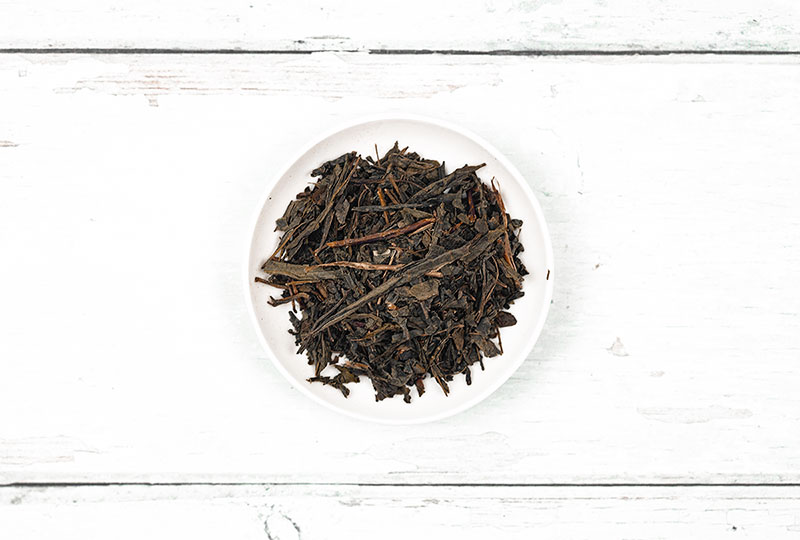How to Make Roasted Tea
If you are not a fan of strong vegetal flavors of Japanese green teas or want to reduce the caffeine intake, while still enjoying the benefits of green tea, roasted tea may be the right answer. Roasted tea has a lower caffeine content than regular green tea and a unique and tempting aroma. Learn how to brew a perfect cup of hojicha and how to roast tea at home.
What is roasted tea?
Roasted tea or hojicha is a type of Japanese green tea. This Japanese tea has been around for 100 of years and still enjoys a high popularity because of its unique flavor and low caffeine content. Hojicha is mostly made from bancha tea leaves, but it can be made from sencha too. Older, more mature tea leaves in bancha have a naturally lower caffeine content, which is further reduced by roasting. However, regardless of the roasting process, hojicha still preserves a high antioxidant activity. Studies showed that free radical scavenging ability of hojicha is higher than the one in oolong or black tea[1].
Hojicha can be lightly or heavily roasted. It usually has bigger tea leaves with stalks and stems. If you prefer toasty and nutty taste over vegetal green flavor, hojicha may be the right tea for you.
How to Prepare Hojicha
Hojicha tastes delicious both hot and cold. Because of its strong and unique flavor, you can use it for making delicious lattes too. It’s perfect for making refreshing iced tea.
To make a cup of hot hojicha tea, use about 2-5 grams of tea per cup of water, depending on how strong you want your tea to be. Choose fresh spring water rather than hard tap water.
- Bring water to a boil.
- Pour boiling water into a teapot to preheat it. The best teapot for making hojicha is either a Japanese kyusu or tetsubin.
- Place the tea leaves into a teapot.
- Wait till the water is down to 194- 203°
- Pour hot water over the tea leaves.
- Steep for 45-90 seconds, depending on the water temperature and how strong you want it to be.
- Re-steep. You can use boiling water for any subsequent infusions.
You can steep the tea longer than one minute, but don’t over-steep. Even though hojicha has a lower caffeine content and milder flavor, it can still turn out bitter.
How to make your own hojicha?
You can easily make roasted green tea at home too. The best types of tea for making hojicha are bancha, kukicha, Japanese sencha, Chinese sencha and pan-fired green teas with longer and flatter leaves.
To make your own roasted tea, you will need a clean frying pan, stove and green tea. First, clean the pan and make sure it’s completely dry. Then preheat the pan on a stove over medium or low fire. You can use a higher temperature, but you would risk burning the leaves too. Put the tea leaves into the pan. Let them roast why gently shaking the pan. Once they start changing the color and you can feel the roasted scent, you are done – or nearly done. You can roast them either lightly or heavily, but be careful not to burn them.
Roasting is a great way of saving the tea leaves that are no longer very fresh. If you accidentally ruined sencha or bancha green tea by placing it on a direct sunlight, by roasting you can still save it. Roast only smaller quantities of tea that you plan to use within a short period of time. That way you will be able to enjoy the best and freshest roasted aroma of hojicha.
Can you roast other teas?
Yes, some other teas are great for roasting too. Lightly oxidized ball-shaped oolongs are perfect for roasting at home. Choose teas that either have a vegetal flavor or already a nutty and toasty flavor. Another great tea to roast at home is South American Yerba Mate. Yerba mate comes from a different plant than real tea, but it also contains caffeine. Choose pure yerba mate tea leaves and roast them in the same way as you would green tea leaves. Use the roasted leaves for making hot or iced tea.
Disclaimer: This article is for informational purposes only. It’s not intended to replace medical advice, diagnosis or treatment. Every person is different and may react to different herbs and teas differently. Never use teas or herbs to treat serious medical conditions on your own. Always seek professional medical advice before choosing home remedies.
References:
[1] https://pubmed.ncbi.nlm.nih.gov/16638659/





